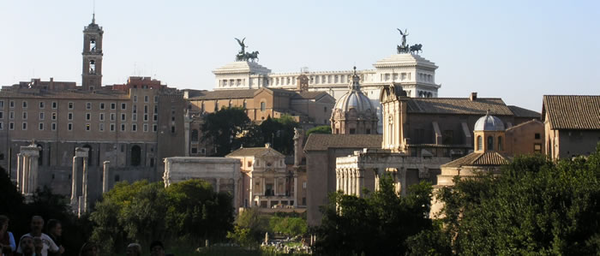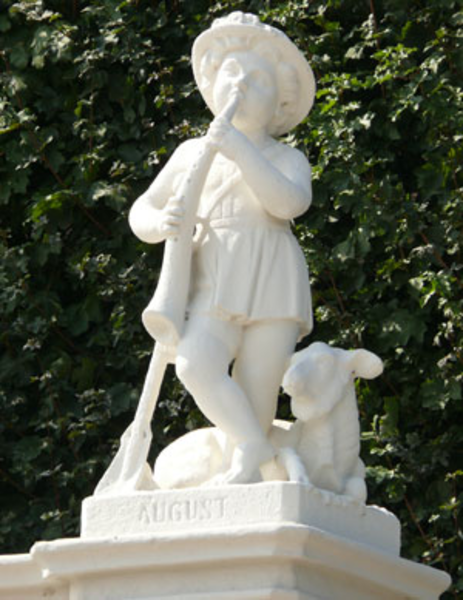Items where Author is "Coote, Lesley"
 | Up a level |
Group by: Item Type | No Grouping
Jump to: Resource
Number of items: 19.
Resource
Gladiator, Epic and Rome pics
Shared with the World by Dr Lesley Coote
Some pics of 'epic' Rome, and a few notes on the film Gladiator, with notes on its epic qualities. Usable with ideas of epic genre, literature through film. Pictures feature triumphal arches, the Collosseum, the equestrian statue of Marcus Aurelius, the Pantheon, and Trajan's Markets (a two-story Roman 'shopping mall'!). My own photographs, taken in open access, public areas.
Shared with the World by Dr Lesley Coote
Baroque Garden, the Belvedere Vienna
Shared with the World by Dr Lesley Coote
Some pictures of the Belvedere Garden in Vienna, with a quick reference 'factfile' in support of the images.
The Belvedere is a free access, public space. I have not included images of the restricted parts of the garden or palace. The photographs are my own.
Shared with the World by Dr Lesley Coote
Le Morte Darthur What's Where guide
Shared with the World by Dr Lesley Coote
Guide to what's where in Thomas Malory's Le Morte Darthur. The numbers refer to page numbers in Helen Cooper's edition for Oxford World's Classics, but can be used with other editions, as all is in the same order.
Shared with the World by Dr Lesley Coote
Paradise Lost Guide
Shared with the World by Dr Lesley Coote
Don't get lost in Paradise Lost!
Here is a quick reference guide to who and what is where in Milton's epic. Can be used with any edition.
Shared with the World by Dr Lesley Coote
Epic Qualities overview
Shared with the World by Dr Lesley Coote
A list illustrating the nature of the epic genre, linking medieval epic (in this case, especially the Song of Roland and the Bayeux Tapestry) with epic film (in this case, Gladiator, Fall of the Roman Empire, and El Cid...)
Shared with the World by Dr Lesley Coote
A list of topics and issues in Restoration/Enlightenment literature and culture
Shared with the World by Dr Lesley Coote
A list of topics and issues in Early Modern literature and culture, arising from study of Aphra Behn, but used to contextualise all my Early Modern and Enlightenment texts. Can be used 'as is' or adapted, changed, challenged, added to etc...
Shared with the World by Dr Lesley Coote
A class on the Restoration using descriptive terms as a discussion starter
Shared with the World by Dr Lesley Coote
This class concentrates on the Restoration, but the methodology can be used for any classes...
Shared with the World by Dr Lesley Coote
making a poster for assessment
Shared with the World by Dr Lesley Coote
These instructions were designed for students making posters for a seventeenth-century assessment. They can be used for classwork, for just about any purpose. Thinking about posters, dvd and book covers can help students organise their thoughts for writing essays.
Shared with the World by Dr Lesley Coote
Gest of Robin Hood in modern English
Shared with the World by Dr Lesley Coote
A modern English rendition of The Gest of Robin Hood, for use with non-Middle English students, etc...etc...or as a parallel text
Shared with the World by Dr Lesley Coote
classical rhetorical devices
Shared with the World by Dr Lesley Coote
A quick 'ready-to-use' resource...a list of classical rhetorical devices, as an aid to spotting them. Brief, and to the point...I use this with Restoration/Early Enlightenment students
Shared with the World by Dr Lesley Coote
quick glossary of film terminology
Shared with the World by Dr Lesley Coote
Want to talk about film but not sure what the terms mean? The terminology actually does help to analyse the film clip or still images from films. It can be put onto a vle, or given to students as a handout.
Shared with the World by Dr Lesley Coote
Discussion starter with images
Shared with the World by Dr Lesley Coote
Another discussion starter, can be used with any suitable subject. As with all class activities, equality of access has to be borne in mind.
Shared with the World by Dr Lesley Coote
Discussion starter with drawing
Shared with the World by Dr Lesley Coote
I used this with Margaret Cavendish's Female Orations, each group making an image of the 'lady' described by Cavendish in her 'academy'. I then photographed the images for display on the class vle. The idea can be used with any suitable text/s. As with all class activity, equal opportunity has to be borne in mind.
Shared with the World by Dr Lesley Coote
approaching short texts or poems with performance technique
Shared with the World by Dr Lesley Coote
A good way of approaching a 'difficult' text, particularly suitable as an ice-breaking exercise for new students. Very good for Medieval/renaissance/early modern, but can be used with any suitable text from any period.
Shared with the World by Dr Lesley Coote
Tips for writing a reflective, explanatory text in support of a project
Shared with the World by Dr Lesley Coote
A generic ready-to-use or adaptable resource for explaining how to write an explanatory text in support of a project. This is used in literature projects, as an aid to assessment, but can be used in order to help devise learning outcomes and assessment criteria. For more on creative assessment criteria, see the ESC project, on the ESC site.
Shared with the World by Dr Lesley Coote
Tale of Gamelyn in modern English
Shared with the World by Dr Lesley Coote
A modern English version of the Gamelyn story...for quick reference, or use as a parallel text, or with people who cannot (or don't want to) cope with the Middle English text
Shared with the World by Dr Lesley Coote
Prince of Thieves scene-by-scene
Shared with the World by Dr Lesley Coote
Another scene-by-scene for a popular film with medievalists and history tutors, as a ready-to-use resource or a template for adaptation or application to another film of your choice.
Shared with the World by Dr Lesley Coote
Robin and Marian scene-by-scene
Shared with the World by Dr Lesley Coote
A scene-by-scene account of a film frequently used by medievalists. This can be used as a 'user-ready' resource for classes, or as a template for writing your own account of any film you wish to use.
Shared with the World by Dr Lesley Coote
Tips for analysing a film clip
Shared with the World by Dr Lesley Coote
Tips for film clip analysis, for class preparation and for assessment.
Shared with the World by Dr Lesley Coote
![[img]](http://www.humbox.ac.uk//2355/2.hassmallThumbnailVersion/capskyscape.jpg)

![[img]](http://www.humbox.ac.uk//2354/2.hassmallThumbnailVersion/belvedere-august.jpg)



